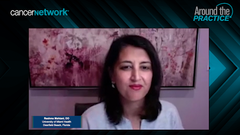
Patient Case 1: 62-Year-Old Woman With a Palpable Lump in Right Breast
Patient Case 1 is presented to the panel, and Vijayakrishna Gadi, MD, PhD, shares his thoughts on how to approach treatment of this patient.
Episodes in this series

Sara Hurvitz, MD: Moving on segment 2, we still need audience participation. The first case is a 62-year-old woman who has a palpable 3-cm lump in her right breast. The biopsy shows HER2 [human epidermal growth factor receptor 2]–positive hormone receptor–negative breast cancer. She has de novo metastases in the lung based on a PET [positron emission tomography]–CT scan—I assume the lung was biopsied to confirm that—and the MRI of the brain was negative. She initially received docetaxel-trastuzumab-pertuzumab for 6 cycles, then maintenance trastuzumab-pertuzumab in the frontline setting. Eight months later, when she was rescanned, there was a progression in her lungs.
Which therapy would you offer this patient after progression of disease on THP [docetaxel, trastuzumab, pertuzumab]? T-DM1 [trastuzumab emtansine], tucatinib-trastuzumab-capecitabine, T-DXd [trastuzumab deruxtecan], or lapatinib-capecitabine? Vote on what you would do in the second-line setting for somebody whose disease is progressing after THP [docetaxel, trastuzumab, pertuzumab]. T-DXd [trastuzumab deruxtecan] is the winner. T-DM1 [trastuzumab emtansine] is being selected by about 20% of our participants. Only 7% of people selected tucatinib-based therapy. What do you think about this, V.K.? Is this how you would address a patient whose disease is progressing in the lungs with no brain metastases after THP [docetaxel, trastuzumab, pertuzumab]?
Vijayakrishna Gadi, MD, PhD: It makes sense to me. We have a phase 3 study that shows that this is the choice agent in this context. It’s hard to argue. It’s hard to argue with 22 zeros in a P value in terms of PFS [progression-free survival]. I can understand some people wanting to wait for the survival data; it’s very reasonable. For the quarter of folks who are sticking with T-DM1 [trastuzumab emtansine] in this patient, that makes sense too because there’s a big difference in the tolerability of the agents. We have data showing that when this is used in a slightly later line, it’s still active. If you’re looking at the patient in front of you, you make choices, but those choices are reasonable.
Sara Hurvitz, MD: Reshma, if a patient has lung metastases, like this patient, does that give you pause? What do we know about ILD [interstitial lung disease] in patients with lung metastases?
Reshma Mahtani, DO: It does give me pause if a patient is symptomatic from lung metastases. It may be challenging to differentiate subtle changes in their symptoms. It could be because of progression of their disease vs ILD [interstitial lung disease]. But if someone has lung metastases, that wouldn’t be a reason for me not to use it. The responses with this therapy happened very early. We’re expecting to see a response in terms of disease symptom-related improvement, and we expect to see that early. This agent is studied in patients with primary lung cancer. In terms of risk factors, to characterize those who are at risk for ILD, the presence of lung metastases was not identified as a baseline risk factor. There were data that showed that in the earlier dose-finding studies, the higher dose in patients of Japanese origin were at a higher risk. Some patients don’t make it to later lines of therapy, and our paradigm is to use our best active agents up front.
Sara Hurvitz, MD: Neil, assuming you use T-DXd [trastuzumab deruxtecan] in the second-line setting, what does your third-line therapy look like? What treatment will you use after progression on second-line T-DXd [trastuzumab deruxtecan]?
Neil Iyengar, MD: That gets to the question of, where do we put T-DM1 [trastuzumab emtansine] now? Especially if we’re using this in the second line. As we begin using T-DM1 [trastuzumab emtansine] more in the adjuvant setting, it’s nice to have another option in the second-line setting. The vast majority of my patients are seeing T-DM1 [trastuzumab emtansine] in the adjuvant setting. I would move on from T-DXd [trastuzumab deruxtecan] in the second line to the tucatinib-based regimen in the third line. Alternatively, if the patient has not seen T-DM1 [trastuzumab emtansine] before, do we feel comfortable using T-DM1 [trastuzumab emtansine] after exposure to another ADC [antibody-drug conjugate], trastuzumab deruxtecan? There’s nothing biologically or mechanistically that would make me uncomfortable doing that. When we consider the data for the tucatinib-based regimen, it has shown to be effective after multiple prior lines of therapy, and I feel comfortable with the tucatinib-based regimen in the third-line setting if we’re using T-DXd [trastuzumab deruxtecan] in the second-line setting.
Sara Hurvitz, MD: Excellent response.
This transcript has been edited for clarity.
Newsletter
Stay up to date on recent advances in the multidisciplinary approach to cancer.






















































































